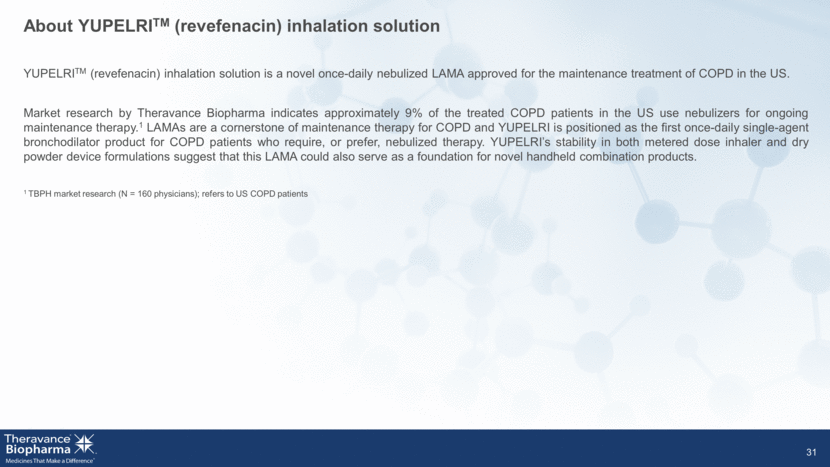Attached files
| file | filename |
|---|---|
| 8-K - 8-K - Theravance Biopharma, Inc. | a19-2024_18k.htm |
| EX-99.2 - EX-99.2 - Theravance Biopharma, Inc. | a19-2024_1ex99d2.htm |
Theravance Biopharma, Inc. (NASDAQ: TBPH) Investor Presentation January 2019 THERAVANCE®, the Cross/Star logo, and MEDICINES THAT MAKE A DIFFERENCE® are registered trademarks of the Theravance Biopharma group of companies. All third party trademarks used herein are the property of their respective owners. © 2019 Theravance Biopharma. All rights reserved.
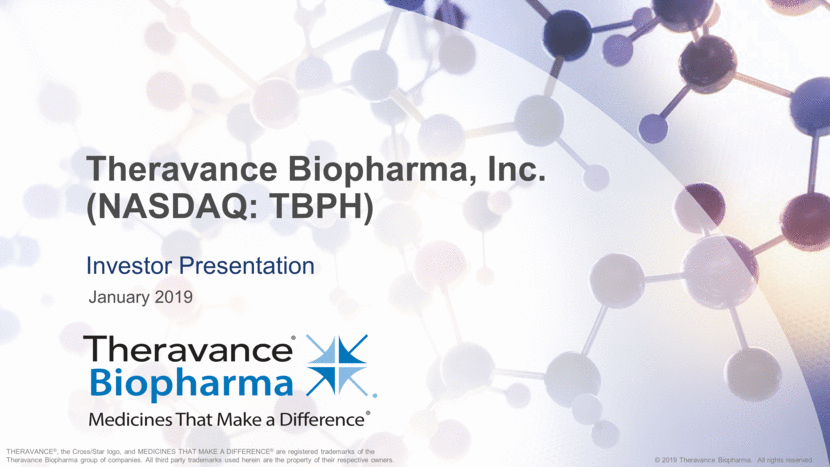
Forward Looking Statements Under the safe harbor provisions of the U.S. Private Securities Litigation Reform Act of 1995, the company cautions investors that any forward-looking statements or projections made by the company are subject to risks and uncertainties that may cause actual results to differ materially from the forward-looking statements or projections. Examples of forward-looking statements in this presentation include statements relating to the company’s business plans and objectives, including financial and operating results, potential partnering transactions and sales targets, the company’s regulatory strategies and timing and results of clinical studies, the potential benefits and mechanisms of action of the company’s product and product candidates (including their potential as components of combination therapies). The company’s forward-looking statements are based on the estimates and assumptions of management as of the date of this presentation and are subject to risks and uncertainties that may cause the actual results to be materially different than those projected, such as risks related to delays or difficulties in commencing or completing clinical studies, the potential that results from clinical or non-clinical studies indicate product candidates are unsafe or ineffective (including when our product candidates are studied in combination with other compounds), delays or failure to achieve and maintain regulatory approvals for product candidates, risks of collaborating with third parties to discover, develop and commercialize products, risks associated with establishing and maintaining sales, marketing and distribution capabilities. Other risks affecting the company are described under the heading “Risk Factors” and elsewhere in the company’s Form 10-Q filed with the Securities and Exchange Commission (SEC) on November 8, 2018, and other periodic reports filed with the SEC. 2
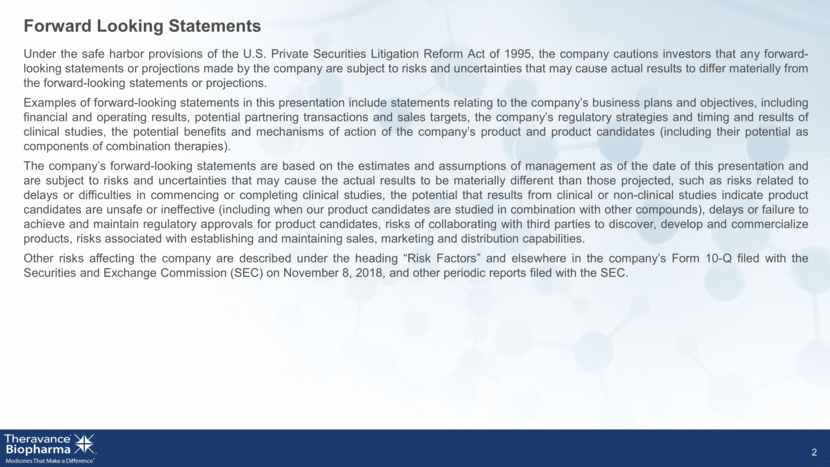
3 Focus on discovering transformational medicines Create value from strategic integration of key functional insights Focus on transformative products to deliver value to payers, patients and HCP’s Pursue medicines with difficult-to-replicate design characteristics for long term competitive advantage Proven development expertise to deliver innovation Leverage preclinical data and translational science expertise to design clinical studies that provide insights and maximize value of early programs Integrated approach accelerates time to pivotal studies Partnerships to complement and expand existing expertise Established commercial infrastructure surrounds value proposition Strategic objective to transform the treatment of serious diseases with novel, locally acting organ-selective therapies Insight and Innovation Drive Long-term Growth
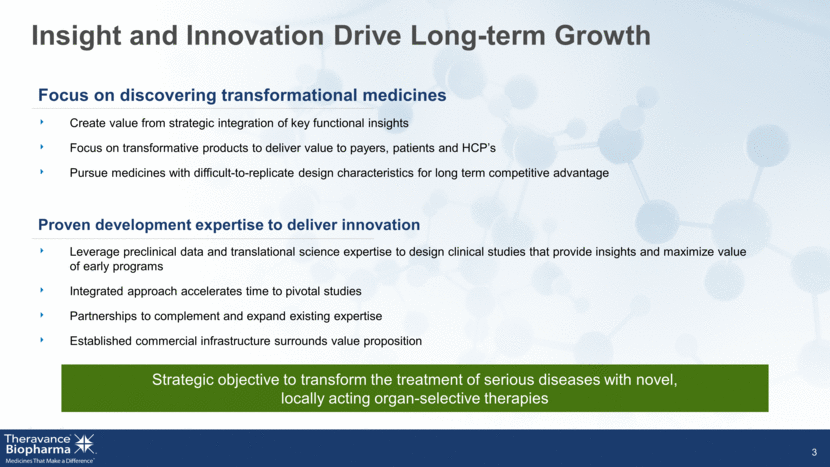
4 Conventional Oral Compound Permeability Solubility Bioavailability, % Systemic Clearance GI Tissue : Plasma Ratio Organ-selectivity Aimed to Expand Therapeutic Index EFFECTIVE NON-EFFECTIVE DOSE-LIMITING SAFETY NON-EFFECTIVE DOSE-LIMITING SAFETY EFFECTIVE Theravance Biopharma Organ-selective Compound Illustrated example: lung selectivity
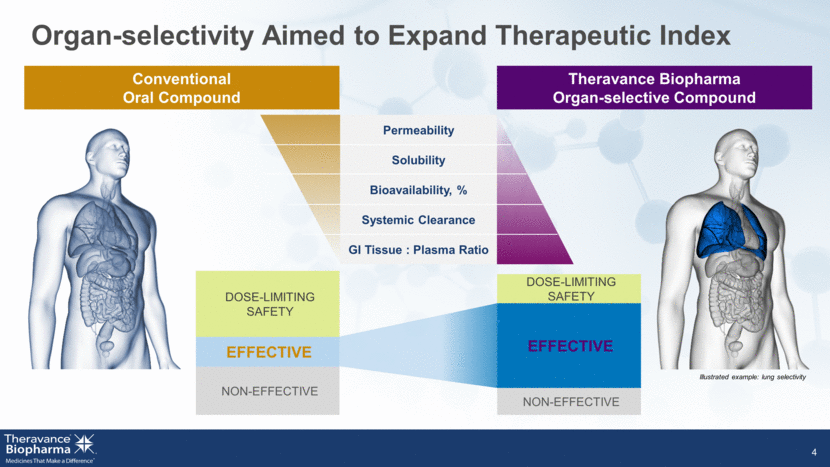
5 First patient dosed in Phase 2 study in Crohn’s TD-1473 Patient screening in Phase 2b/3 study in UC TD-1473 Completion of Phase 2a study in nOH Ampreloxetine Sites initiated for Phase 3 program enrollment Ampreloxetine Global collaboration agreement with Janssen TD-1473 Completion of Phase 1b study in UC TD-1473 Initiation of FIH study of lung-selective JAKi TD-8236 Completion of Phase 3b PIFR study YUPELRITM FDA approval and commercial launch YUPELRITM 1 Pro forma cash of approximately $570M excluding expected 4Q18 loss. 2 Economic interest. TBPH holds 85% economic interest in upward-tiering royalty stream of 6.5% – 10% payable by GSK (net of TRC LLC expenses paid and the amount of cash, if any, expected to be used by TRC pursuant to the TRC LLC Agreement over the next four fiscal quarters). YUPELRITM (revefenacin) inhalation solution. UC: ulcerative colitis. FIH: first in human. JAKi: Janus kinase inhibitor. nOH: neurogenic orthostatic hypotension. PIFR: peak inspiratory flow rate. $250M transaction (net proceeds ~$230M)1 TRELEGY ELLIPTA2 Debt Royalty 2018 Key Milestones
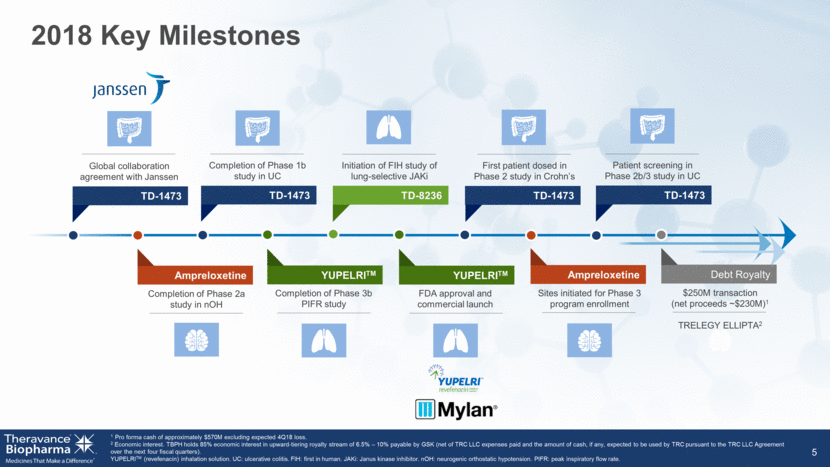
6 Commercial organization to concentrate on YUPELRITM Economic interest in TRELEGY ELLIPTA serves as an important strategic asset1 Strong launch following approvals in US and EU in late 2017 TD-1473, ampreloxetine, and YUPELRITM each internally discovered and developed by R&D engine which serves as important driver of long term value APPROVED BY FDA First once-daily nebulized LAMA for treatment of COPD; launch underway Positive top-line four-week results in nOH Initiating pivotal Phase 3 program in symptomatic nOH TD-1473 (JAKi) Ampreloxetine (NSRI) YUPELRITM (LAMA) Partnership with global leader in Immunology Phase 2 study in Crohn’s disease underway and initiating pivotal Phase 2b/3 study in ulcerative colitis 1 TBPH holds 85% economic interest in upward-tiering royalty stream of 6.5% – 10% payable by GSK (net of TRC LLC expenses paid and the amount of cash, if any, expected to be used by TRC pursuant to the TRC LLC Agreement over the next four fiscal quarters). NSRI: norepinephrine serotonin reuptake inhibitor. LAMA: long-acting muscarinic antagonist. COPD: chronic obstructive pulmonary disease. Strategic Focus in 2019

YUPELRITM (revefenacin) inhalation solution Nebulized long-acting muscarinic antagonist (LAMA)

YUPELRITM: Now Commercially Available FDA-APPROVED FOR THE MAINTENANCE TREATMENT OF COPD 8 FEV1: forced expiratory volume in one second. LABA: long-active beta agonist. ICS: inhaled corticosteroid. Single cycle approval ahead of expected PDUFA date, without an Advisory Committee Higher of two doses approved: 175 mcg once daily, for use with any standard jet nebulizer Label incorporates: Data illustrating change from baseline in trough FEV1 after 12 weeks of dosing Data illustrating sustained treatment effect over 24 hours Observed improvements across a range of patients 37% of patients took concomitant LABA or LABA/ICS Summary of safety data and most common side effects Direction to store at room temperature
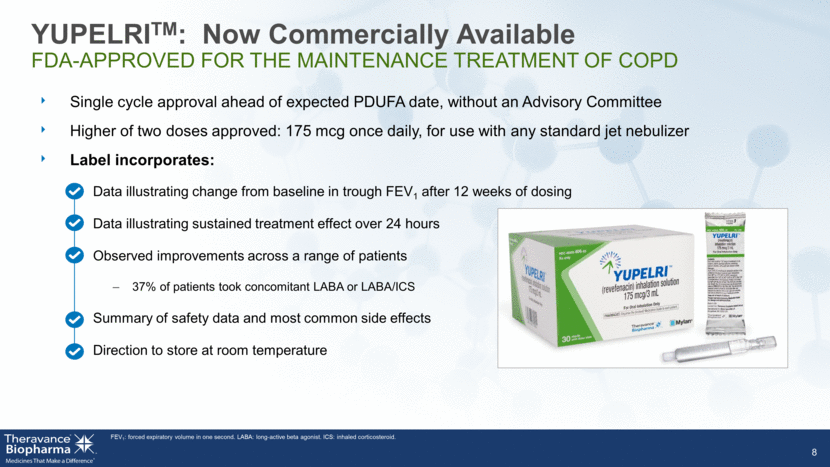
NDA Supported by Positive Phase 3 Results TWO REPLICATE EFFICACY STUDIES, PLUS 12-MONTH SAFETY STUDY 9 Pooled analysis. Primary endpoint achieved for both doses in replicate efficacy studies Robust and sustained improvements in FEV1 Study included use as monotherapy as well as add-on to LABA or LABA/ICS Generally well tolerated in 12-month safety study * * * Monotherapy Concomitant LABA Pooled Population * P < 0.0001 versus placebo 175 mcg
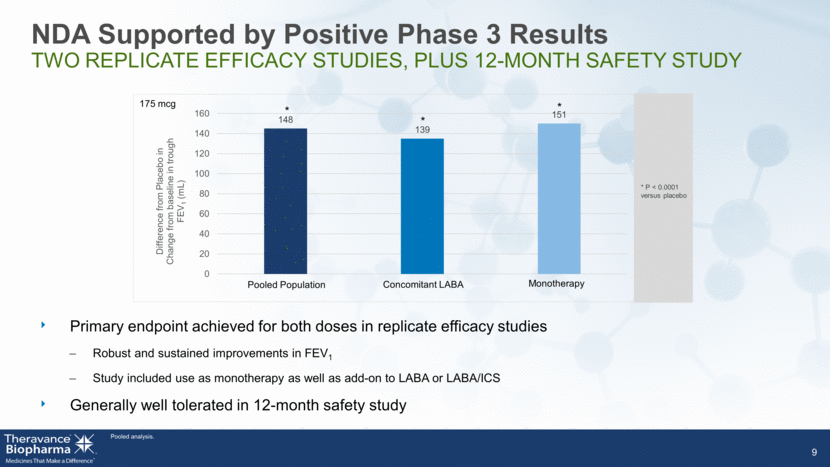
Partnership with Mylan Provides Commercial Strength in Nebulized Opportunity 10 1 IMS Health information service: NSP for period MAT May, 2015. Excludes nebulized SABAs. IMS expressly reserves all rights, including rights of copying, distribution and republication. 2 TBPH market research (N = 160 physicians); refers to US COPD patients. HD = hospital discharge. Enduring patient niche and significant market opportunity >100M patient treatment days in nebulized COPD segment1 9% of COPD patients currently use nebulizers for ongoing maintenance therapy2 41% of COPD patients use nebulizers at least occasionally for bronchodilator therapy2 Combined sales infrastructures to cover Hospital, Hospital Discharge and Home Health settings HD +
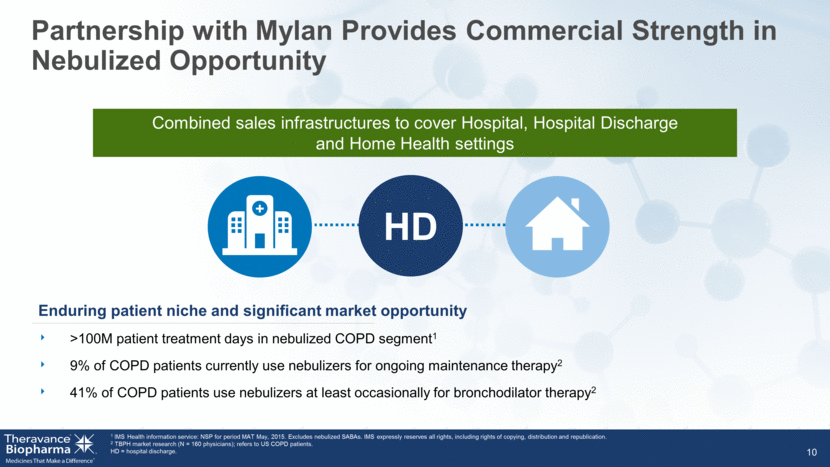
TD-1473 JAK Inhibitor Program Oral gut-selective pan-Janus kinase (JAK) inhibitor for ulcerative colitis and other inflammatory intestinal diseases
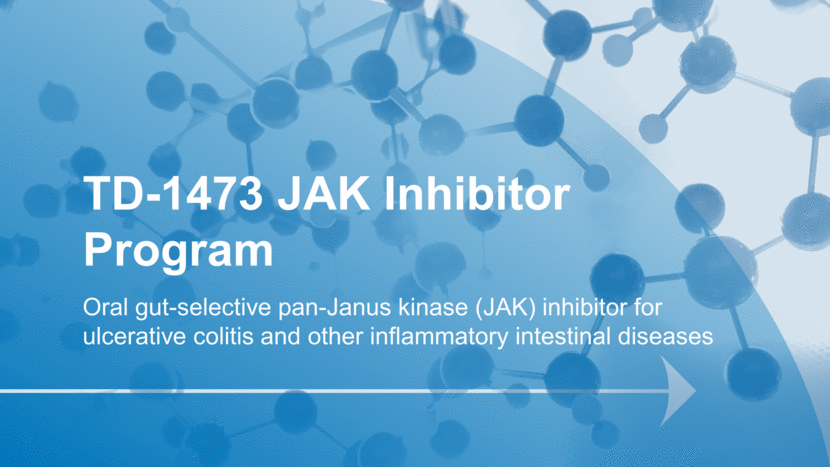
Differentiated and Potential Breakthrough Approach ADVANCING IN COLLABORATION WITH JANSSEN IN UC AND CROHN’S 12 TD-1473 program objectives: Oral pan-JAK inhibitor that distributes selectively throughout the intestines to treat inflammatory intestinal disease locally, with minimal systemic exposure or corresponding immunosuppressive effects, to enhance safety and efficacy Phase 1b study in UC patients complete Data demonstrated localized biological target engagement with minimal systemic exposure Clinical responses after only 4 weeks of therapy Preclinical models of UC confirmed Improvements in diseases scores, local absorption and penetration of TD-1473 throughout intestinal tract Phase 3 enabling toxicology complete Favorable safety margins in 6 and 9 month studies

Encouraging Findings in Phase 1b Study 4-WEEK TREATMENT IN 40 PATIENTS WITH ULCERATIVE COLITIS 13 Detailed results presented in oral late-breaker at UEGW 2018; Phase 2 in Crohn’s disease underway and progressing into Phase 2b/3 in UC 1 Clinical response as measured by both partial and full Mayo. 2 Surrogate biomarkers include C-reactive protein (CRP) and fecal calprotectin. Key Findings Favorable overall safety and tolerability No systemic or opportunistic infections (including herpes zoster) No evidence of reduce white cell counts Minimal systemic exposure Plasma levels of TD-1473 very low Consistent in all cohorts to levels observed in healthy volunteers Biologic activity in GI tract Endoscopic improvements and mucosal healing reported in all active arms; none reported in placebo arm Rectal bleeding scores improved above placebo at highest two doses Rates of clinical response higher for all active doses compared to placebo1 Clinical responses matched by dose-dependent reductions in surrogate biomarkers2 Dose-related increases in local GI tissue drug concentrations; higher two doses produced mean concentrations above JAK IC50
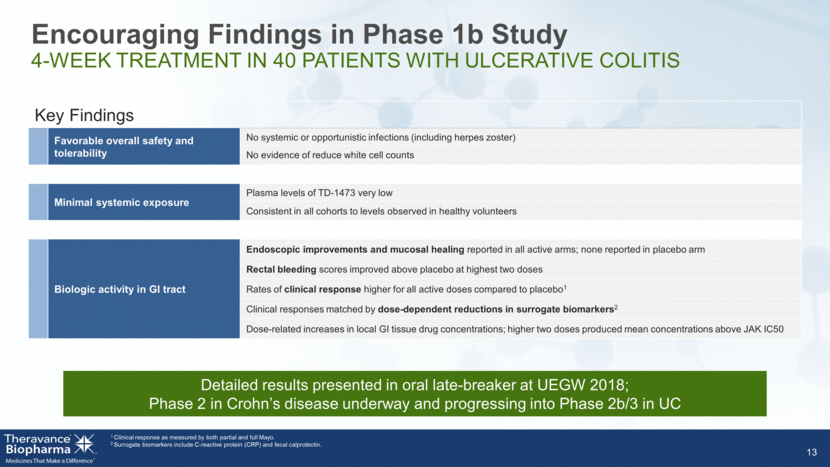
Phase 3 induction, 2 arms (N=640) Dose-confirming induction, 8 weeks Phase 2b induction, 4 arms (N=240) Dose-finding induction, 8 weeks 14 Phase 3 maintenance 44 weeks Phase 2b/3 study in ulcerative colitis Phase 2 study in Crohn’s disease Phase 2 study, 3 arms (N=160) Dose-finding induction, 12 weeks Active treatment extension, 2 arms 24 weeks Responders Responders Late-stage Studies of TD-1473 in UC and Crohn’s Disease
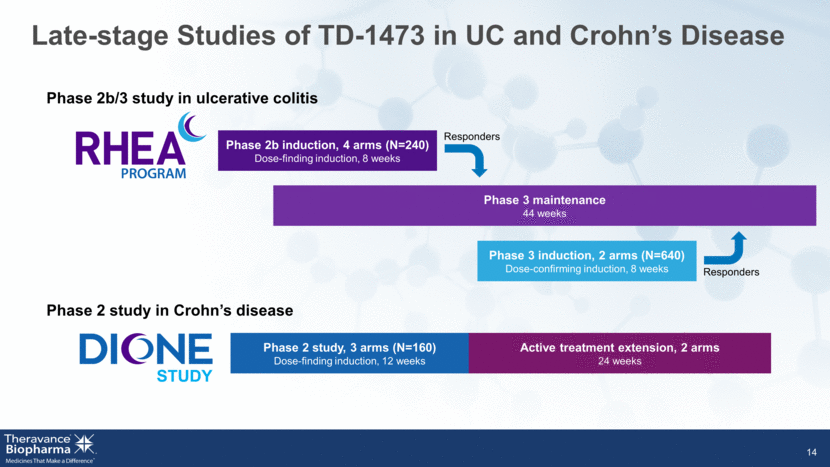
Global Collaboration Agreement for TD-1473 PURPOSED TO MAXIMIZE VALUE OF PROGRAM 15 Shared belief in TD-1473 as gut-selective with potential to transform the treatment landscape in inflammatory intestinal disease Meaningful program enhancements Accelerate clinical development and advance UC and Crohn’s in parallel Apply Janssen expertise in IBD to optimize clinical strategy and execution Maximize worldwide commercial opportunity Attractive deal economics reducing overall financial risk Deal value up to $1B milestones, including $100M upfront; additional profit-share in US Collaboration with global leader in immunology represents milestone for TD-1473, our internally discovered pipeline and strategy to design organ-selective medicines
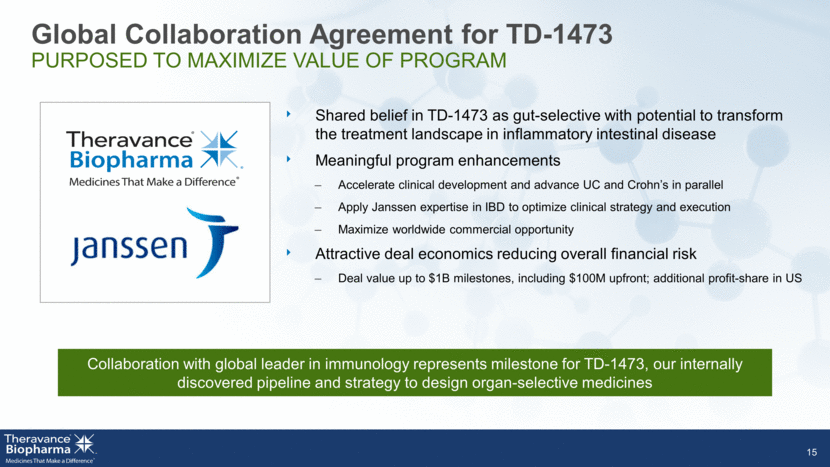
Ampreloxetine (TD-9855) Once-daily dual norepinephrine and serotonin reuptake inhibitor (NSRI) for neurogenic orthostatic hypotension (nOH)

17 1 Existing options associated with one or both therapies noted above; Northera prescribing information. MSA: multiple system atrophy. PD: Parkinson’s disease. PAF: primary autonomic failure. TID: three times per day. nOH characterized by a sustained drop in blood pressure upon standing, due to body producing insufficient levels of norepinephrine (NE) Associated with several autonomic disorders: MSA, PD, PAF Symptoms include dizziness, fainting, blurred vision and weakness Orphan indication with < 200k patients in US Opportunity exists for safe and effective treatment Only droxidopa (Northera) and midodrine FDA-approved for nOH Synthetic exogenous NE analogues impact disease by increasing vascular tone Limitations of current therapy: Supine hypertension, TID dosing, patients refractory or discontinue, lack of durability1 Ideal therapy would target durable improvement in symptoms and daily function NE NE NE NE NET NET NE Vasodilation lowers blood pressure Blood pressure key biological driver to nOH symptoms Symptomatic nOH Represents a Significant Unmet Need
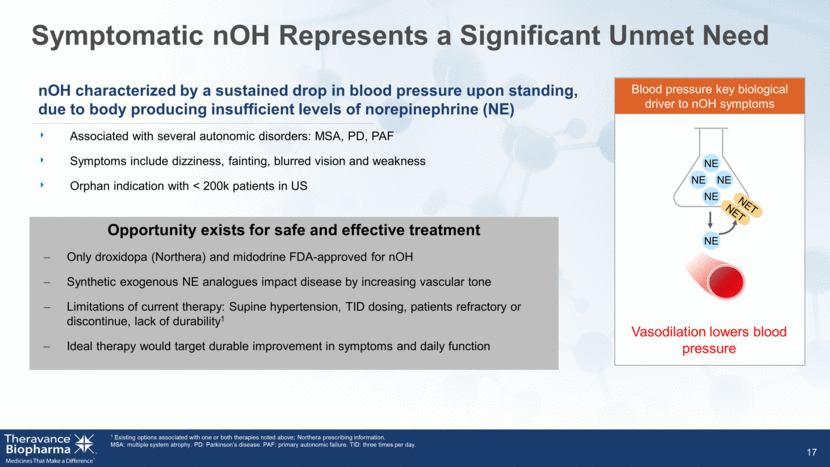
NET Inhibition with Ampreloxetine Offers Potential to Restore Vascular Sympathetic Tone 18 1 Includes Phase 1 SAD/MAD, elderly, and PET studies in healthy subjects and Phase 2a studies in fibromyalgia and ADHD patients. NET: norepinephrine transporter. QD: once-daily. A path to treating symptomatic nOH without introducing exogenous NE Blockade of NET in nOH patients inhibits endogenous neuronal NE uptake Increased levels of NE in the synapse cause vasoconstriction and a corresponding increase in blood pressure Increase in blood pressure improves symptoms Rationale for ampreloxetine in nOH NSRI with NE dominance confirmed in humans QD dosing, long half-life, and metabolic profile for potential improved patient outcomes Favorable safety and tolerability profile established in > 500 subjects1 Vasoconstriction to increase blood pressure + Ampreloxetine NE NE NE NE NET NET NE NE NE
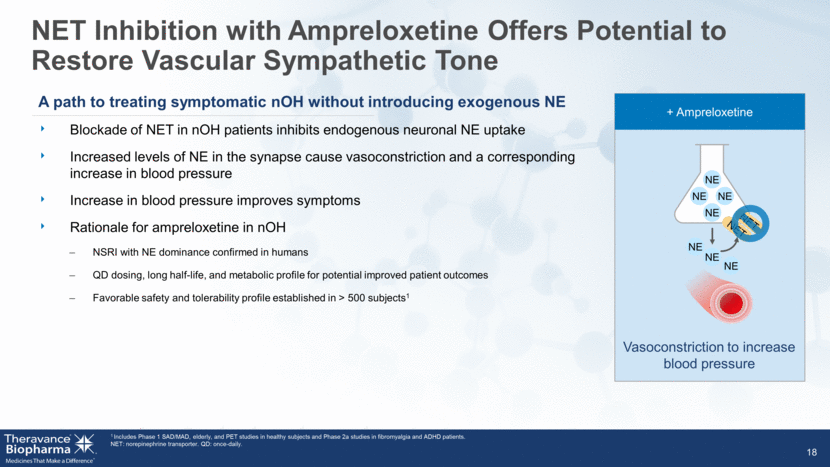
Overview of Phase 2 Study in nOH DESIGNED TO EVALUATE INITIAL AND DURABLE RESPONSE TO THERAPY 19 Purpose: To evaluate the effect of ampreloxetine in improving blood pressure and key nOH symptoms Part C: Responders in Part A eligible for open-label treatment for up to 5 months Designed to assess durability of effect Primary assessment at four weeks (Day 29) Efficacy evaluations: OHSA1 #1, standing time duration, standing systolic blood pressure Also assessed safety and pharmacokinetics of ampreloxetine 1 OHSA: Orthostatic Hypotension Symptom Assessment. OHSA #1 measures dizziness (cardinal symptom of nOH), lightheadedness, feeling faint, or feeling of impending black out. Three-part design in patients with nOH: Single ascending dose portion of ampreloxetine (up to 20 mg) Testing blood pressure response to ampreloxetine A Patients started on Part A, and responders moved to Part B and/or Part C (extension phase) Double-blind Placebo-controlled Single dose (Part A response dose) or placebo B Extension phase Open label design Up to 24 weeks (20 weeks dosing, 4 week wash out) Primary endpoint at 4 weeks C
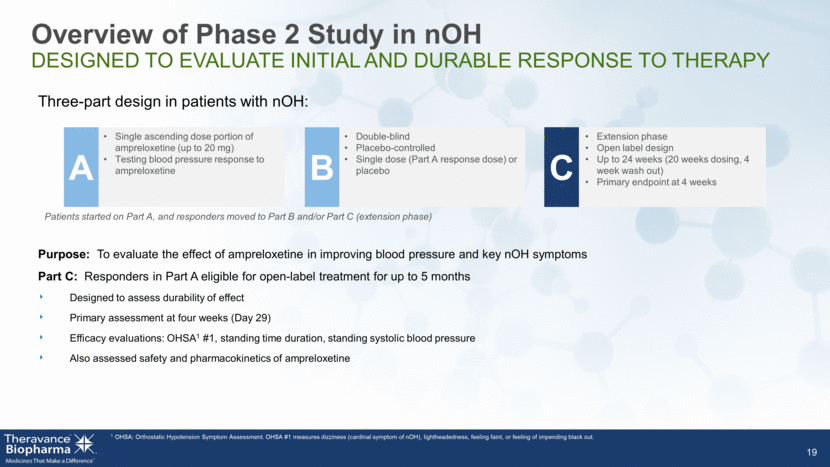
20 Part B change from baseline systolic blood pressure (n=10) LS Mean+ / - SE Change from Baseline (mmHg) Top-line Phase 2 Results in nOH PARTS A and B: SINGLE ASCENDING DOSE, TD-9855 OR PLACEBO Initial responses observed A Responses reported in majority of patients treated 27 of 34 patients enrolled in Part A showed improvements in SBP and/or standing time Responses observed above 5 mg Confirmation vs. placebo B Statistically significant difference of 30 mmHg at 4 hours post-dose (p = 0.011) Ampreloxetine increased SBP from a low baseline SBP dropped on placebo during day as expected, due to postural changes and eating No evidence of supine hypertension with ampreloxetine overnight SBP: systolic blood pressure.
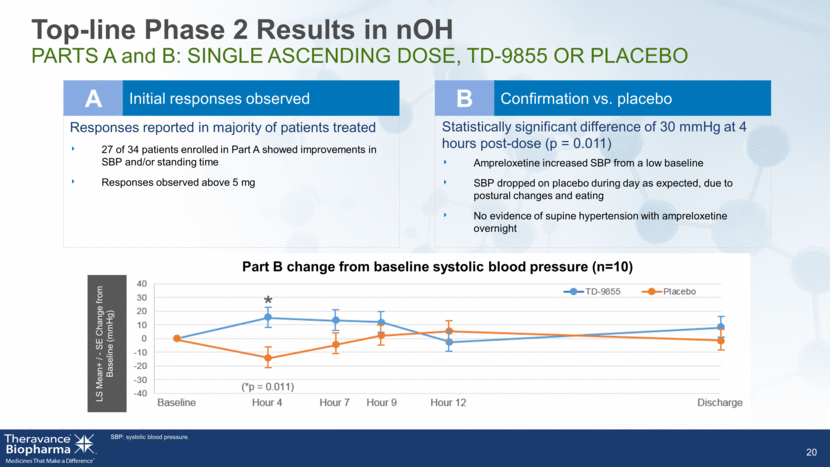
21 Top-line Phase 2 Results in nOH PART C: REPEAT DOSE EXTENSION PHASE Durability of effect observed out to 4 weeks C 16 of 21 patients (76%) completed four weeks of treatment Reductions in symptom severity, with most pronounced benefit in patients with symptomatic nOH1 Mean reduction in OHSA #1 = 2.4 points at four weeks (n=16) 13 completers had OHSA #1 > 4 points at baseline; mean reduction in group = 3.8 points at four weeks Consistent increases in SBP through four weeks Clinically meaningful increases in standing SBP (7 mmHg or greater) after standing for three minutes at all time points on all weekly clinic visits Generally well tolerated; no serious adverse events assessed as drug-related Positive results including durability of effect provide basis to begin registrational Phase 3 program in symptomatic nOH in early 2019 1 Symptomatic defined as OSHA #1 > 4.
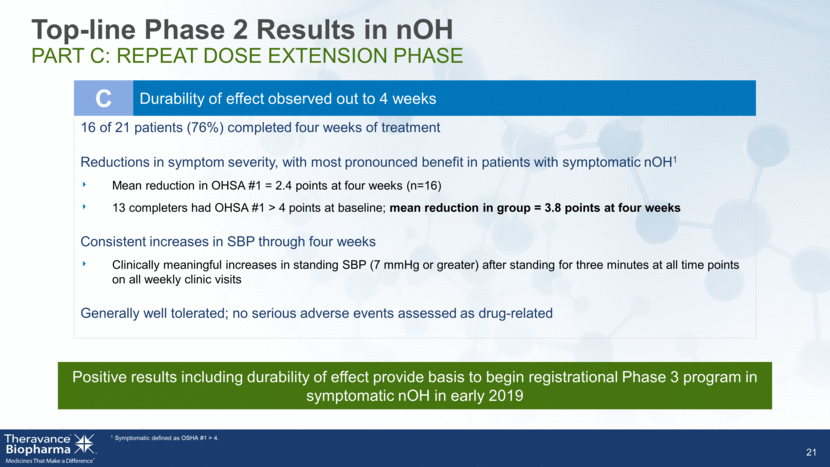
TD-8236 Potential first inhaled non-steroidal anti-inflammatory for moderate-to-severe asthma regardless of Th2 phenotype
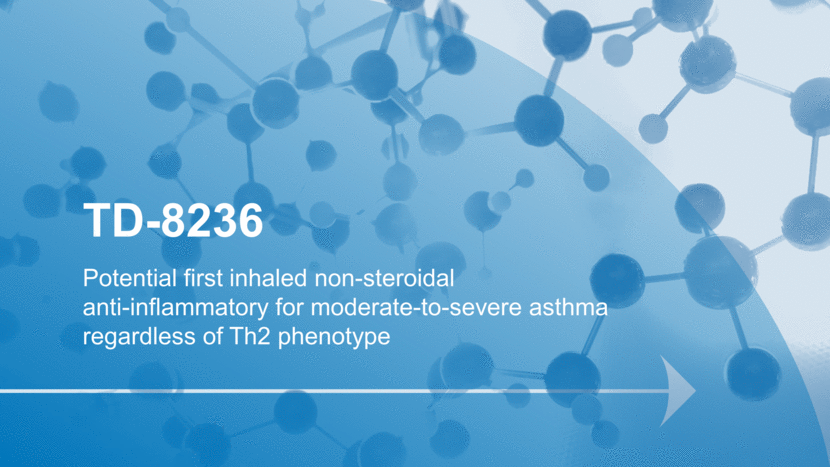
23 Small portion of US patients cause high proportion of cost Severe 14% Moderate 16% Severe 61% Moderate 25% 16M diagnosed asthma cases1 Healthcare utilization2 Patient population 4.9M moderate-to-severe diagnosed patients in US1 Current treatments Inhaled steroids, which often fail to control disease Approved biologics affect subsets of patients Burden of disease Acute exacerbations lead to ER visits Uncontrolled symptoms interfere with ability to sleep, work and QOL US medical costs estimated to be $58B3 Disproportionate healthcare utilization by severe and uncontrolled asthmatics High frequency of hospitalizations and increased use of systemic medications 1 © 2018 DR/Decision Resources, LLC. All rights reserved. Reproduction, distribution, transmission or publication is prohibited. Reprinted with permission. 2 Sadatsafavi, M., et al. Can Respir J, 2010 17(2): 74-80. 3 Nurmagambetov, T., et al., Ann Am Thorac Soc. 2018. High Medical and Economic Burden in Uncontrolled Asthma
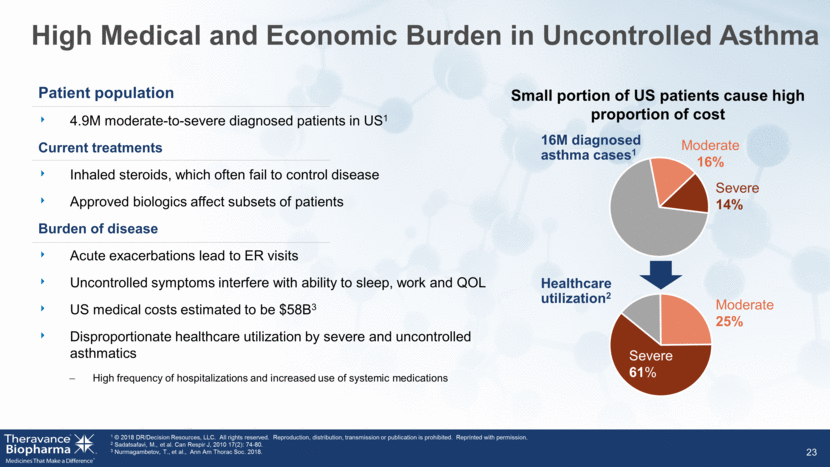
JAK/STAT cytokines implicated in severe asthma Th2 High Th2 Low IL-4 IL-23/IL-12 IL-13 IL-6 IL-5 IL-27 TSLP IFN- 24 Mixed granulocytic Eosinophilic Neutrophilic Paucigranulocytic Patient heterogeneity in severe asthma Th2 Low Th2 High Bold denotes biologics in development or approved Novel approved biologics address only Th2 high asthma Key treatment needs: Prevention of exacerbations and symptom control for patient population regardless of Th2 phenotype Potential for Inhaled pan-JAKi to Address Needs of Patients Regardless of Th2 Phenotype Simpson JL, et al. Resp 2006;11:54-61. TD-8236 potently inhibits proposed mediators of Th2 high and Th2 low asthma in human cells Program goal: a potent, inhaled, non-steroidal anti-inflammatory with broad activity in airway inflammation 38 19 29 7
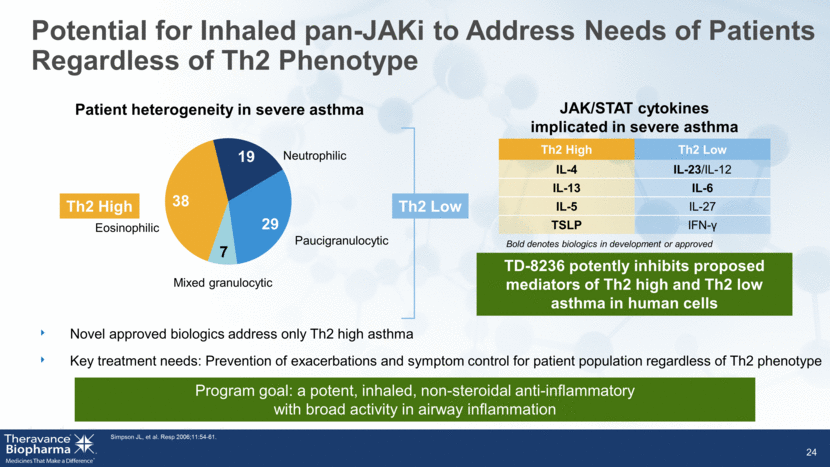
Potent pan-JAKi Lung selective Long duration of action 25 Therapeutic Index High TD-8236 levels and long residence time in mouse lung Low levels in blood Time (h) Concentration (g/g, g/mL) TD-8236’s profile supports a once-daily inhaled product with minimal systemic exposure TD-8236 is Optimized for Dry Powder Delivery to the Lung
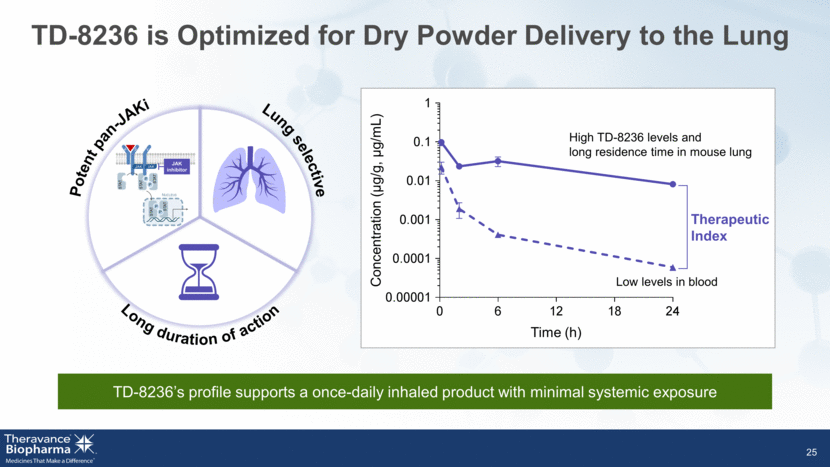
Economic Interest GSK’s FDA-approved TRELEGY ELLIPTA (FF/UMEC/VI): First and only once-daily single inhaler triple therapy

GSK’s TRELEGY ELLIPTA: Strong Early Trajectory FIRST AND ONLY ONCE-DAILY SINGLE INHALER TRIPLE THERAPY 27 Economic interest in TRELEGY ELLIPTA Upward-tiering royalty of approximately 5.5% - 8.5% of worldwide net sales1 Passive economic interest; no product cost obligations Impressive progress following first approvals in late-2017 Available in 16 countries Filed in China and Japan; 9 additional approvals expected in 2019 Phase 3 asthma study to complete in early 2019 Recent note transaction augments financial strength into 2019 Non-dilutive private placement of $250 million of 9% non-recourse notes Payable by economic interest in TRELEGY ELLIPTA 75% of royalties to debt repayment until repaid 25% of royalties to the Company Immediate cash infusion with retained economics over TRELEGY ELLIPTA’s commercial lifespan; proceeds to support key strategic priorities Strongest US ELLIPTA launch to date Source: GSK; IQVIA NPA weekly TRx data. This information is an estimate derived from the use of information under license from the following IQVIA information service: NPA for the period November 2013 through October 2018. IQVIA expressly reserves all rights, including rights of copying, distribution and republication. Launched in US in November 2017. ANORO BREO ARNUITY INCRUSE TRELEGY TRELEGY ELLIPTA is FF/UMEC/VI or fluticasone furoate/umeclidinium/vilanterol; comprised of ICS, LAMA, and LABA, active components of Breo (FF/VI) and Anoro (UMEC/VI). 1 TBPH holds 85% economic interest in upward-tiering royalty stream of 6.5% – 10% payable by GSK (net of TRC LLC expenses paid and the amount of cash, if any, expected to be used by TRC pursuant to the TRC LLC Agreement over the next four fiscal quarters). All statements based on publically available information. Trelegy Ellipta jointly managed by GSK and Innoviva (formerly Theravance, Inc.) 0 10,000 20,000 30,000 40,000 50,000 60,000 70,000 80,000 1 2 3 4 5 6 7 8 9 10 11 12 TRx Volume Month Post Launch
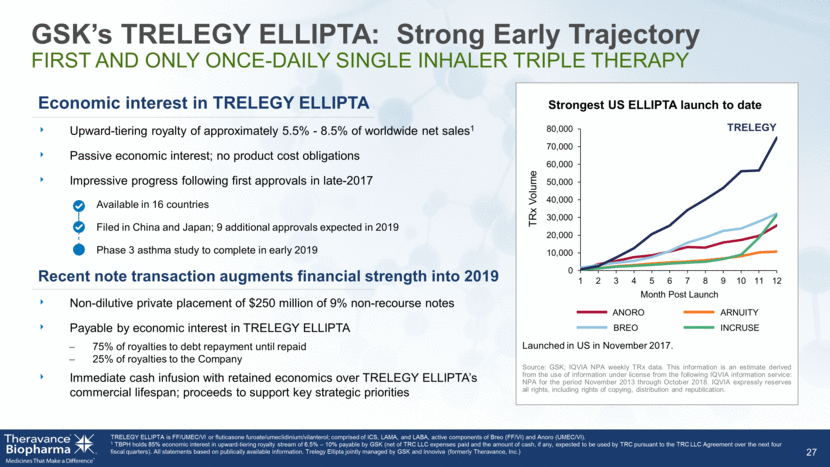
Opportunities for Value Creation Upcoming milestones
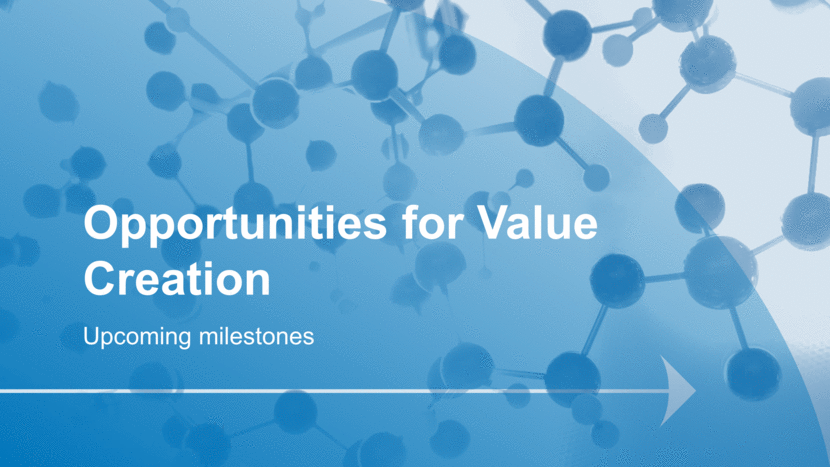
29 Multiple programs advancing into pivotal studies, underpinned by future potential cash flows from TRELEGY ELLIPTA royalties, potential Janssen milestones and YUPELRITM launch Shading denotes studies planned to begin in respective development stage. Program Pre-clinical Early Proof of Concept Pivotal Collaborator TD-1473 Ulcerative colitis TD-1473 Crohn's disease Ampreloxetine (TD-9855) Symptomatic neurogenic orthostatic hypotension TD-8236 Serious respiratory diseases Gastrointestinal JAKi NSRI Inhaled JAKi Development Pipeline Advancing Forward
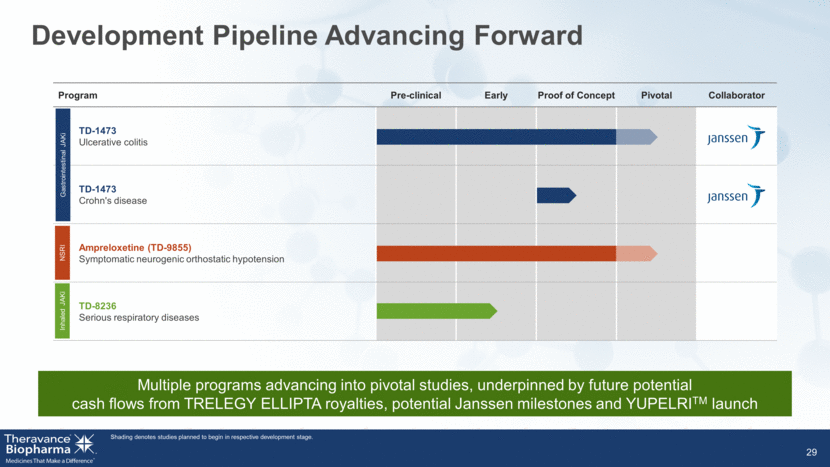
Significant existing cash resources to fund strategic priorities2 Focus on Strategic Priorities COMMITMENT TO CREATING TRANSFORMATIONAL MEDICINES 30 1 Economic interest managed by GSK and Innoviva. Innoviva formerly Theravance, Inc. TBPH holds 85% economic interest in upward-tiering royalty stream of 6.5% – 10% payable by GSK (net of TRC LLC expenses paid and the amount of cash, if any, expected to be used by TRC pursuant to the TRC LLC Agreement over the next four fiscal quarters). All statements based on publically available information. 2 Pro forma cash of approximately $570M excluding expected 4Q18 loss. Opportunities to Create Transformational Medicines YUPELRITM (revefenacin) Nebulized LAMA in COPD FDA-approved, commercial launch underway TD-1473 Intestinally-restricted JAKi for inflammatory intestinal diseases Phase 2 study in Crohn’s disease underway and initiating Phase 2b/3 study in ulcerative colitis Ampreloxetine NSRI in symptomatic neurogenic orthostatic hypotension Initiating Phase 3 program TD-8236 Inhaled JAK inhibitor for serious respiratory diseases First in human studies underway Late-stage research New organ-selective projects in the lung, gut, and eye advancing towards clinic Managed by GSK and Innoviva1 Economic Interest TRELEGY ELLIPTA1 (FF/UMEC/VI) Single inhaler triple therapy in COPD Expected regional expansion including approvals in Japan and China Phase 3 CAPTAIN study (asthma) expected to complete in early 2019
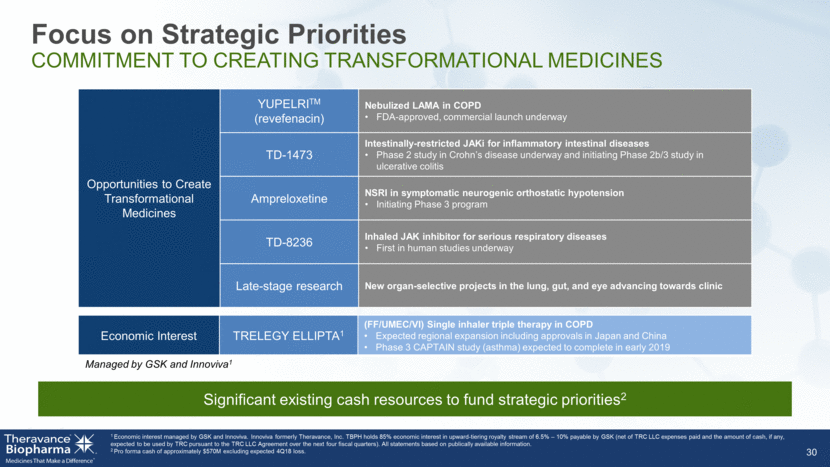
About YUPELRITM (revefenacin) inhalation solution YUPELRITM (revefenacin) inhalation solution is a novel once-daily nebulized LAMA approved for the maintenance treatment of COPD in the US. Market research by Theravance Biopharma indicates approximately 9% of the treated COPD patients in the US use nebulizers for ongoing maintenance therapy.1 LAMAs are a cornerstone of maintenance therapy for COPD and YUPELRI is positioned as the first once-daily single-agent bronchodilator product for COPD patients who require, or prefer, nebulized therapy. YUPELRI’s stability in both metered dose inhaler and dry powder device formulations suggest that this LAMA could also serve as a foundation for novel handheld combination products. 1 TBPH market research (N = 160 physicians); refers to US COPD patients 31
